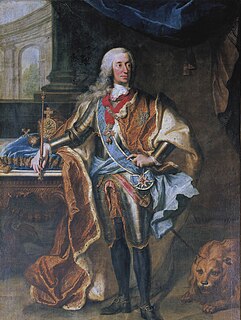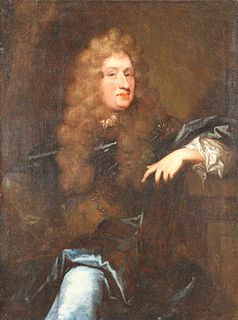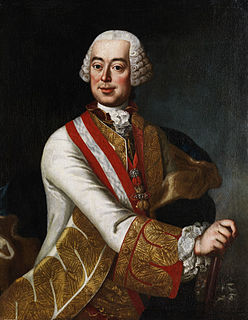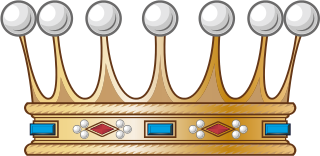
The War of the Polish Succession (1733–35) was a major European war sparked by a Polish civil war over the succession to Augustus II, which the other European powers widened in pursuit of their own national interests. France and Spain, the two Bourbon powers, attempted to check the power of the Austrian Habsburgs in western Europe, as did the Kingdom of Prussia, whilst Saxony and Russia mobilized to support the eventual Polish victor. The slight amount of fighting in Poland resulted in the accession of Augustus III, who in addition to Russia and Saxony, was politically supported by the Habsburgs.

Charles VII was the Prince-elector of Bavaria from 1726 and Holy Roman Emperor from 24 January 1742 until his death in 1745. A member of the House of Wittelsbach, Charles was the first person not born of the House of Habsburg to become emperor in three centuries, though he was connected to that house both by blood and by marriage.

Maurice, Count of Saxony was a German soldier and officer of the Army of the Holy Roman Empire, the Imperial Army, and at last in French service who became a Marshal and later also Marshal General of France. He is best known for his decisive victory at the Battle of Fontenoy and is honored in the Walhalla memorial.

Otto Ferdinand Graf von Abensperg und Traun, was an Austrian Generalfeldmarschall. The current spelling of the name, and the spelling used in his time, is mostly Abensperg.

Friedrich Heinrich Reichsgraf von Seckendorff was a Franconian field marshal and diplomat, in the service of the imperial Habsburg monarchy of Austria. Later he served as commander of the Bavarian army and fought Austria.

Ulrik Frederik Gyldenløve, Count of Laurvig was the leading general in Norway during the Scanian War, whose Norwegian leg is conventionally named the "Gyldenløve War" after him. He was an acknowledged illegitimate son of King Frederick III of Denmark and Norway.

Count Leopold Joseph von Daun, later Prince of Thiano, was an Austrian field marshal of the Imperial Army in the War of the Austrian Succession and Seven Years' War.
Rudolf Graf von Marogna-Redwitz was a Colonel of the Wehrmacht, member of the German Resistance in Nazi Germany and the 20 July Plot against Adolf Hitler at the Wolf's Lair in East Prussia.

Count Karl Josef Batthyány of Németújvár was a Hungarian-Austrian general and field marshal. He served as ban (viceroy) of Croatia from 1743 to 1756.

Franz Emil Lorenz Heeremann Graf von Wimpffen KSMOM was an Austrian General and Admiral who served as Administrative Head of the Austro-Hungarian Navy from 1851 to 1854.

The Siege of Bergen op Zoom took place during the Austrian War of Succession, when a French army, under the command of Lowendal and the overall direction of Marshal Maurice de Saxe, laid siege and captured the strategic Dutch border fortress of Bergen op Zoom on the border of Brabant and Zeeland in 1747. The fortress was defended by Dutch, Austrians, British, Hanoverians and Hessians that supported the Pragmatic Sanction.
Christian Grafvon Forbach, then Christian Marquis de Deux-Ponts and later Christian Freiherrvon Zweibrücken (1752–1817) was an officer of the French army and later a general of the Royal Prussian and then of the Bavarian Army, at last in the rank of General der Infanterie. He may not be confused with his nephew Christian Freiherr von Zweibrücken, who was a Bavarian General of Cavalry.
Philippe Guillaume aka Philipp Wilhelm Grafvon Forbach, then Vicomte de Deux-Ponts and later Freiherrvon Zweibrücken (1754–1807) was an officer of the French and later general of the Bavarian Army.

The Fall of Ghent occurred on 15 July 1745 during the War of the Austrian Succession when a 5,000 strong French force under Ulrich Frédéric Woldemar, Comte de Lowendal surprised and captured the town of Ghent in the Austrian Netherlands. The Allied garrison offered little resistance.
Woldemar is a given name, a variant of Waldemar.

Samuel Graf von Schmettau was a Prussian field marshal.

William of Hesse-Philippsthal-Barchfeld was a member of the House of Hesse and was Landgrave of Hesse-Philippsthal-Barchfeld from 1721 to 1761.
The Rt. Hon. George Charles, Baron de Dyhern, was a Saxon general, war minister under the regency of Augustus III. of Saxony, king of Poland and a close friend of Field Marshal Count Frederick Augustus Rutowsky.
























